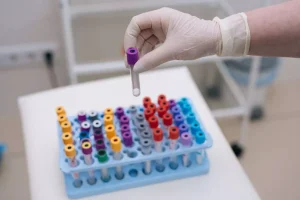
Your genetics can influence how likely you are to develop AUD, but there’s currently no evidence of a specific gene that directly causes AUD once you start drinking. There is evidence that heavy episodic (binge) drinking, which results inexposure of tissues to high levels of alcohol, is particularly harmful81, 87, 88. Binge drinkingis generally defined as a man consuming 5 standard drinks within 2 hours; women are typically smaller and have a lower percentage of body water, so 4 standarddrinks can reach similar alcohol levels. A standard drink is defined in the US as 12ounces of beer, 5 ounces of wine or 1.5 ounces of spirits, all of which approximate14 g of pure ethanol). The strong effects of binge drinking suggest that merelycalculating an average number of drinks per week is likely to obscure many effectsof alcohol, since it treats 2 standard drinks per day (14 per week) fetal alcohol syndrome face celebrities the same as 7drinks on each of two days per week. The GI tract is exposed to very high levels of alcohol as it passes throughthe mouth, esophagus, stomach and intestinal tract, and most ethanol passes throughthe liver before entering the circulation.
What is Alcohol Use Disorder?
The causes of AUD are complex and can involve a variety of factors, including early exposure to alcohol use, peer group pressure, and living with other mental health conditions. He worked for many years in mental health and substance abuse facilities in Florida, as well as in home health (medical and psychiatric), and took care of people with medical and addictions problems at The Johns Hopkins Hospital in Baltimore. Research has suggested that it’s a combination of the above risk factors as well as genetics that could determine whether or not you develop alcohol use disorder. The study is also important because of the massive health and socio-economic impacts of substance abuse in general. Even just looking at alcohol alone there is a vast health cost, with more than 3.3 million people worldwide die each year from excessive alcohol use, according to the World Health Organization. In the United States, the economic costs of alcohol abuse are estimated to be as high as $249 billion each year, according to the Centers for Disease Control.
Some alleles that reduce heavy drinking can,nevertheless, increase risk for disease in the subset of individuals who drinkheavily despite having them. Other than genetics, there are a number of risk factors for developing alcohol use disorder. While there are environmental and social factors that influence the risk for alcoholism, there is also a genetic component.

What gene is responsible for increased AUD risk?

But while research is still ongoing to identify causative and protective genes for alcohol use disorder, it is not currently routine practice to test for these genes. Alcohol use disorder, more commonly known as alcoholism, is characterized by an inability to control ones drinking because of a physical or emotional dependence of alcohol. According to a review from 2016, genes that promote alcohol metabolism and the production of enzymes, such as alcohol dehydrogenase and aldehyde dehydrogenase, can be protective against AUD. Your genetics don’t only increase your risk of AUD — they may have protective elements as well.
The incidence of alcoholism was slightly higher among people who were exposed to alcoholism only through their adoptive families. However, it was dramatically higher among the twins whose biological fathers were alcoholics, regardless of the presence of alcoholism in their adoptive families. Because of this, people with the genes ADH1B and ALDH2 might be less likely to develop the condition than those without it. ADH1B and ALDH2 may also protect against both alcohol consumption and alcohol use disorder.
More than 800,000 of the people affected are children between the ages of 12 and 17 years. Alcohol use disorder (AUD) can have a hereditary component, but not everyone living with AUD has a family history of AUD.
These approacheshave been quite fruitful for some studies and need to be employed in analyses ofalcohol-related traits and phenotypes. Over the next few years, we anticipate theidentification of additional common and rare variants contributing to the risk ofalcohol dependence. There are several other genes that have been shown to contribute to the riskof alcohol dependence as well as key endophenotypes. In most cases, studiesrecruited families having multiple members with alcohol dependence; such familiesare likely to segregate variants that sudden onset alcohol intolerance affect the risk of alcohol dependence.
Other NIDA Sites
- The second step is metabolism of theacetaldehyde to acetate by ALDHs; again, there are many aldehyde dehydrogenases,among which ALDH2 has the largest impact on alcohol consumption20.
- While many studies have been done, and experts agree that there is a hereditary connection, genetics is not the only factor, and we don’t quite know the full impact it has on alcoholism.
- The NIAAA points out that genes are only responsible for about half the risk of developing AUD.
- Despite these advances, the molecular genetic investigation of the AUD diagnosis faces multiple challenges moving forward.
To date, individual GWASstudies on alcohol dependence and related phenotypes have been relatively modestin size, and most do not reach genome-wide significance. This may reflect boththe limited sample sizes and the clinical and genetic heterogeneity of thedisease. As noted above, the functional ADH1B polymorphism isnot represented on GWAS platforms; GABA-receptor genes are often nominallysignificant but well below genome-wide significance in these studies. Thus, thegenes and SNPs found through GWAS have had little overlap with previous findingsbased on candidate genes/pathways and linkage analyses. Given such findings, molecular genetics studies have attempted to identify specific variation within the genome related to increased risk for AUD. Early work in the field focused on genome-wide linkage and candidate gene association studies.
This condition affects several brain systems, which can cause some people to form a physical dependency on alcohol. Genetics may play a role in alcohol use disorder (AUD), but other factors might also contribute to the development of this condition. The researchers believe that even larger studies may help to differentiate the genetics behind alcohol addiction. With current review, we aim to present the recent advances in genetic and molecular studies of AUDs.
CURRENT STATE OF THE AUD GWAS LITERATURE
Like many other complex traits, alcoholism appears to be clinically and etiologicaly hetrogenous[13]. This implies that there might be several steps and intermediate conditions in the development of AUD. Information about the underlying genetic factors that influence risk to AUD can be derived from multiple levels of AUD including amounts of drinks (Alcohol consumption), severity and symptoms of alcohol abuse and dependence. Commonly, genome wide association studies (GWAS) of alcoholism have focused on phenotypes based on the Diagnostic & Statistical Manual of Mental Disorders (DSM)[14]. In the 4th edition of the DSM (DSM-IV), alcohol dependence (AD) and abuse were considered as mutually exclusive diagnoses that together made up AUDs. DSM-V[14, 15] on the other hand consolidated AD and abuse as a single disorder as AUD[15],[16].
The second step is metabolism of theacetaldehyde to acetate by ALDHs; again, there are many aldehyde dehydrogenases,among which ALDH2 has the largest impact on alcohol consumption20. Family, twin, and adoption studies have shown that alcoholism definitely has a genetic component. In 1990, Blum et al. proposed an association between the A1 allele of the DRD2 gene and alcoholism. The DRD2 gene was the first candidate gene that showed promise of an association with alcoholism. The gene variations that result in things like nausea, headaches, and skin flushing with alcohol consumption may be more common in those of Asian or Jewish descent.
In 2021, more than 46 million people in the United States aged 12 or older had at least one substance use disorder, and only 6.3% had received treatment. Moreover, people who use drugs are facing an increasingly dangerous drug supply, now often tainted with fentanyl. Approximately 107,000 people died of drug overdoses in 2021, and 37% of these deaths involved simultaneous exposure to both opioids and stimulant drugs. Drug use and addiction represent a public health crisis, characterized by high social, emotional, and financial costs to families, communities, and society. If your parents or grandparents struggled with alcoholism, you may be more likely to as well. What this means for family members of alcoholics is that you are not necessarily going to misuse alcohol yourself.
Compared to other genetic predictors, the genomic pattern identified here was also a more sensitive predictor of having two or more substance use disorders at once. The genomic pattern linked to general addiction risk also predicted higher risk of mental and physical illness, including addiction recovery art psychiatric disorders, suicidal behavior, respiratory disease, heart disease, and chronic pain conditions. In children aged 9 or 10 years without any experience of substance use, these genes correlated with parental substance use and externalizing behavior.
The former relies on family-based samples to identify regions of the genome that co-segregate with the disorder of interest. Family studies have consistently demonstrated that there is a substantialgenetic contribution to alcohol dependence. Over the past two decades, several genesunderlying susceptibility have been identified.
























